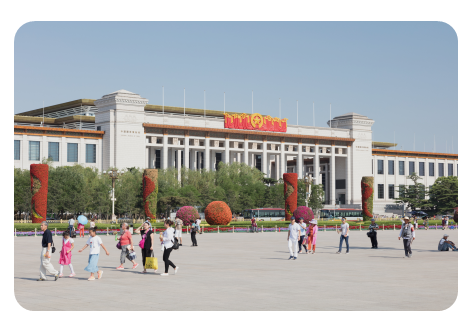China’s Fourth Plenum, a closed-door conference attended by the Communist Party’s 370-member Central Committee, kicked off this week. Many commentators think this could be the most important event on the country’s 2025 economic calendar and will set the tone for China’s growth strategy over the rest of the decade.

We asked Iris Fan, Portfolio Manager, Asia Equities, to help explain the significance of the Fourth Plenum and why it matters for investors
1. How important is this Plenum compared to previous ones?
This is the 15th Fourth Plenum in China’s history. Traditionally, China holds seven plenums within a five-year cycle, each with a different theme. The Fourth Plenum typically focuses on governance matters and in the past, has been an occasion for much political intrigue and high-powered sackings.
This time, the government announced that the Fourth Plenum will focus instead on the country’s five-year plan. Not only is this a deviation from the past, but the days of simple economic roadmaps for China are over. This week’s Plenum is expected to ratify a national strategy for navigating a new era of intense geopolitical tension, domestic economic pressure and a shift towards multipolarity.
As such, the Plenum this week is less about China’s GDP growth targets, and more about its ability to maintain self-sufficiency, domestic consumption and economic resilience, while at the same time ensuring China’s global competitiveness.
2. What are the top economic priorities and concerns for the China Government going into the next 5 years?
Back in 2020, the Chinese government introduced the concept of “Dual Circulation”. This was an important turning point for China because it marked an ideological shift from export-led to more internally-led growth. In President Xi’s words, “It is necessary to promote the formation of a new development pattern which takes the domestic circulation as the mainstay while internal-external dual circulation reinforce each other”.
We think this 15th Fourth Plenum will map out the next phase of the “Dual Circulation” execution master plan and address some of the biggest challenges ahead. These include how to rebalance supply and demand, how to counter deflationary pressures, how to promote household income growth and finally, how to increase the level of China’s GDP per capita.
Additionally, this plenum is grappling with China’s very long term structural trends such as the absolute decline and rapid aging of its population. The need to narrow the urban-rural economic development gap and promote common prosperity has also not gone away.
3. What are the policy initiatives within the new 5-year plan?
A full recount of major policy outcomes will be released when the plenum concludes on Thursday. But ahead of this, we would expect a number of key items to be at the core of China’s future economic planning. Top considerations are national security, global innovation leadership and self-reliance, especially given America First policies and US-China decoupling.
On the internal circulation front, the focus will be to reinforce China’s self-sufficiency in technology agriculture and healthcare. The leadership will also be keen to boost household consumption through income distribution reforms and expanding the social safety net. Further anti-involution measures will similarly rely on a shift from supply-centric to demand-centric policies.
On the external circulation front, we expect details to promote trade diversification and internationalisation, especially those needed to secure supply chains for critical resources such as semi-conductors, energy and food. This is likely to be achieved by fostering more trade relationships with markets that are less vulnerable to geopolitical shocks.
And in terms of key national strategies, we anticipate policies to limit carbon emissions, raise the retirement age, incentivise births, and improve aged care.
4. How sustainable is the current China rally and which sectors are likely to benefit the most?
Liquidity has driven the US, European and even Latin American markets to new all-time highs but this is still not the case for China. At its current level, the CSI 300 index is about 40 percent below its all-time high reached in 2021 before the Covid pandemic. Given the relatively low valuations, still-subdued foreign participation and potential catalysts emerging from this week’s plenum, we believe that the China rally has some way to go.
Another important point to note is the available domestic liquidity. Domestic household deposits in China now stand at close to US$40 trillion, far above the domestic A share market’s total capitalisation of US$13 trillion. Yet options for deploying these savings are becoming more limited. Fixed deposits and government bonds are yielding only about 1.0 percent and 1.5 percent respectively. Meanwhile, individuals’ overseas investing ability is limited by the quota system while property investing has dwindled since the start of China’s real estate woes.
That leaves only the domestic stock market and just a small percentage of the above liquidity is enough to continue propelling the rally. In terms of sectors, the plenum reinforces existing innovation themes such as AI, biotech, advanced materials, precision machine tools and medical devices. The dual circulation focus points to services sectors like tourism, childcare, elderly care, insurance. We also see more upside for sectors targeted by the anti-involution drive, including steel, solar, auto, commodities and chemicals. Over the longer term, sectors benefiting from mega projects and property stabilisation measures such as property, construction, and infrastructure should recover.
5. What is the potential impact on other Asian markets?
Other Asian markets could benefit from China’s consumption growth, excess capacity reduction and offshoring of low-value added manufacturing activities. We think ASEAN markets are well-positioned to receive manufacturing FDI, integrate into China-centric green and tech supply chain while benefiting from Chinese tourism consumption.
Meanwhile, North Asia markets with significant tech and semiconductor focus could face competition from China’s technological advancements. On the other hand, any additional QDII quotas could make the region’s high-dividend paying companies an attractive investment target for Chinese investors. Overall, we think the economic goals of the Fourth Plenum, if fulfilled, will be positive for both China and its Asian neighbours.

Iris joined UOB Asset Management in 2021. She is an investment analyst within the Asia Equities team covering China and Hong Kong macroeconomics and equity markets. Prior to joining the company, Iris worked in Investment Management at Credit Suisse. She started her career as an Economist at an investment research boutique, specialising in Asia.
Iris received her Bachelor of Science (Honours) in Economics from University College London in the United Kingdom. She is a CFA charterholder as well as a certified Financial Risk Manager (FRM). Iris brings with her over 12 years of financial industry experience.
All information in this publication is based upon certain assumptions and analysis of information available as at the date of the publication and reflects prevailing conditions and UOB Asset Management Ltd (“UOBAM”)'s views as of such date, all of which are subject to change at any time without notice. Although care has been taken to ensure the accuracy of information contained in this publication, UOBAM makes no representation or warranty of any kind, express, implied or statutory, and shall not be responsible or liable for the accuracy or completeness of the information.
Potential investors should read the prospectus of the fund(s) (the “Fund(s)”) which is available and may be obtained from UOBAM or any of its appointed distributors, before deciding whether to subscribe for or purchase units in the Fund(s). Returns on the units are not guaranteed. The value of the units and the income from them, if any, may fall as well as rise, and is likely to have high volatility due to the investment policies and/or portfolio management techniques employed by the Fund(s).
Please note that the graphs, charts, formulae or other devices set out or referred to in this document cannot, in and of itself, be used to determine and will not assist any person in deciding which investment product to buy or sell, or when to buy or sell an investment product. An investment in the Fund(s) is subject to investment risks and foreign exchange risks, including the possible loss of the principal amount invested. Investors should consider carefully the risks of investing in the Fund(s) and may wish to seek advice from a financial adviser before making a commitment to invest in the Fund(s). Should you choose not to seek advice from a financial adviser, you should consider carefully whether the Fund(s) is suitable for you. Investors should note that the past performance of any investment product, manager, company, entity or UOBAM mentioned in this publication, and any prediction, projection or forecast on the economy, stock market, bond market or the economic trends of the markets is not necessarily indicative of the future or likely performance of any investment product, manager, company, entity or UOBAM or the economy, stock market, bond market or economic trends of the markets. Nothing in this publication shall constitute a continuing representation or give rise to any implication that there has not been or that there will not be any change affecting the Funds. All subscription for the units in the Fund(s) must be made on the application forms accompanying the prospectus of that fund.
The above information is strictly for general information only and is not an offer, solicitation advice or recommendation to buy or sell any investment product or invest in any company. This publication should not be construed as accounting, legal, regulatory, tax, financial or other advice. Investments in unit trusts are not obligations of, deposits in, or guaranteed or insured by United Overseas Bank Limited, UOBAM, or any of their subsidiary, associate or affiliate or their distributors. The Fund(s) may use or invest in financial derivative instruments and you should be aware of the risks associated with investments in financial derivative instruments which are described in the Fund(s)’ prospectus.
This advertisement has not been reviewed by the Monetary Authority of Singapore.
UOB Asset Management Ltd Co. Reg. No. 198600120Z




